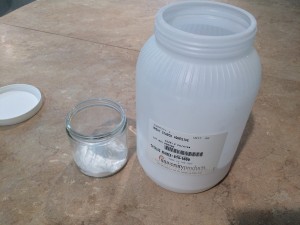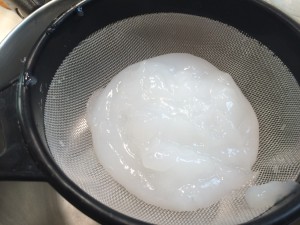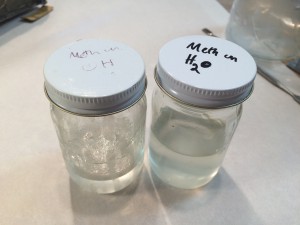Adhesives are an essential part of book and paper conservation. If you want to repair a paper tear you have to use some sort of adhesive, and it’s important to choose an archival adhesive. Archival adhesives won’t turn yellow or become brittle over time, and most importantly they’re reversible. Reversibility is a big factor so future conservators can remove your mends if they need to – maybe to see what’s under it, or it could be interfering with a treatment they want to do, or maybe they just know a way to repair the same tear with a better technique.
There are two main adhesives I use to make archival paper mends – wheat starch paste and methylcellulose. There are lots of different archival adhesives out there and this is by no means an extensive list, but these are the adhesives that I always reach for and use the most often.
Wheat Starch Paste
It’s a paste, that’s made from wheat starch.

Paste in its dry powder form, before cooking
Wheat starch is widely used because it’s easy to make, easy to store, relatively inexpensive, archival, and strong. It’s also very versatile – you can make paste that is extremely dry and thick, but you can still make viable repairs when it’s watered down to the consistency of skim milk (paste consistencies are always measured via a dairy scale for some reason. It can get kind of gross).

Paste, after cooking, ready to be strained
There are loads of different ways to make paste out of wheat starch and which one of these ways is the best way is a fierce topic of debate between conservators and bookbinders. Some choose to cook theirs on the stove while others in the microwave. Some leave their starch to soak overnight in cold water before they cook it, some strain it with only a horse hair strainer, etc etc etc… No matter what exact recipe you choose to follow the process basically calls for adding water to dry wheat starch and applying heat. The starch will gel and become sticky, and that’s your paste. After the paste is made it needs to be pushed through a strainer of some sort to make it smooth, and then water is added to create the right consistency.
The benefits of paste: versatile, easy to make.
The drawbacks of paste: cooked paste doesn’t keep well and it won’t be long before you need to make more.
Methylcellulose
The other adhesive I reach for during paper mending is methylcellulose, which in it’s dry state is a white powder made from vegetable cellulose. You may have heard of methylcellulose before – it’s used as an emulsifier and thickener in processed foods and cosmetics, and I was also surprised to discover that it’s also used as a laxative.
Methylcellulose adhesive typically creates a much weaker bond than wheat starch paste. Sometimes this is a good thing – if you’re working with a very weak object you don’t want to make a very strong mend. But I rarely find a paper that is so weak I can’t use some dilution of wheat starch on it, so I typically use methylcellulose in water as a poultice to rehydrate dried glue on spine linings or whatnot and I use methylcellulose in ethanol to make mends on papers that are prone to tide lines. Diluted methylcellulose can also be used as a paper size.

Jars of methylcellulose
To cook methylcellulose in water you first need to dissolve it in cold water and apply heat to make it gel up (once again, there are a number of ways to accomplish this). With alcohol, I mix the powder with the appropriate amount of ethanol and let it sit overnight. Also like wheat starch paste the viscosity can be modified depending on how much water/alcohol you use, but unlike with paste the correct amount of liquid should be measured out before cooking rather than diluting the finished product.
Benefits of methylcellulose: you can make it in water or alcohol, keeps longer than paste.
Drawbacks of methylcellulose: not very strong, can leave a “sheen” when dry.
What I’ve chosen to highlight here are the two of the perhaps most commonly used adhesives in a book and paper lab, but there are lots of choices out there. Wheat starch and methylcellulose are versatile but they don’t address every situation, so if you have a problem that these adhesives don’t solve do some research and ask around, there is an adhesive out there to meet your needs.

prepairing methylcellulose in water requiers some care, as disolves in cold water and bild up viscosity , and disolves in water above 80°C. It is better to disolve it in hot water to avoid lumbs.
errata, i ment disperce above 80°C
This is my method which works well. I use Rice Flour, add cold water, stir and into the microwave for 45 seconds, stir and do 35 seconds, stir and try 25 seconds, a few goes at 15 seconds stirring in between each heating. If you have too much water, repeat the 35 seconds. If you are short of water, add boiling water and stir. If you add cold water you will get lumps. I never strain my past as it isn’t necessary.